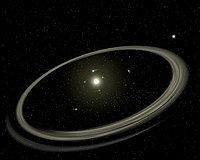
Multiple planetary systems: Properties of the current sample
Sign Up to like & getrecommendations! Published in 2017 at "New Astronomy"
DOI: 10.1016/j.newast.2017.02.003
Abstract: Abstract We carry out analyses on stellar and planetary properties of multiple exoplanetary systems in the currently available sample. With regards to the stars, we study their temperature, distance from the Sun, and metallicity distributions,… read more here.
Keywords: planetary systems; current sample; systems properties; properties current ... See more keywords

The role of disc torques in forming resonant planetary systems
Sign Up to like & getrecommendations! Published in 2020 at "Astronomy and Astrophysics"
DOI: 10.1051/0004-6361/201936390
Abstract: The most accurate method for modelling planetary migration and hence the formation of resonant systems is using hydrodynamical simulations. Usually, the force (torque) acting on a planet is calculated using the forces from the gas… read more here.
Keywords: planetary systems; role disc; planet; gravity ... See more keywords

Tracking Advanced Planetary Systems (TAPAS) with HARPS-N
Sign Up to like & getrecommendations! Published in 2021 at "Astronomy and Astrophysics"
DOI: 10.1051/0004-6361/202037892
Abstract: We present the current status of and new results from our search for exoplanets in a sample of solar-mass, evolved stars observed with the HARPS-N and the 3.6-m Telescopio Nazionale Galileo (TNG), and the High… read more here.
Keywords: planetary systems; solar mass; mass; advanced planetary ... See more keywords

Stellar clustering and orbital architecture of planetary systems
Sign Up to like & getrecommendations! Published in 2021 at "Astronomy and Astrophysics"
DOI: 10.1051/0004-6361/202040201
Abstract: Revealing the mechanisms shaping the architecture of planetary systems is crucial for our understanding of their formation and evolution. In this context, it has been recently proposed that stellar clustering might be the key in… read more here.
Keywords: planetary systems; planets orbiting; orbital architecture; architecture planetary ... See more keywords

Generating metal-polluting debris in white dwarf planetary systems from small-impact crater ejecta
Sign Up to like & getrecommendations! Published in 2020 at "Monthly Notices of the Royal Astronomical Society"
DOI: 10.1093/mnras/staa621
Abstract: Metal pollution in white dwarf photospheres originates from the accretion of some combination of planets, moons, asteroids, comets, boulders, pebbles and dust. When large bodies reside in dynamically stagnant locations – unable themselves to pollute… read more here.
Keywords: planetary systems; generating metal; metal; white dwarf ... See more keywords

Stability of planetary systems within the S-star cluster: the Solar system analogues
Sign Up to like & getrecommendations! Published in 2022 at "Monthly Notices of the Royal Astronomical Society"
DOI: 10.1093/mnras/stac462
Abstract: A dynamically relaxed dense cluster comprised of about 40 stars (the so-called S-stars) inhabits the central region of the Galaxy. Their stars revolve around the Sgr A* massive object. To understand the dynamical evolution of… read more here.
Keywords: system; cluster; star cluster; stability ... See more keywords

Architectures of exoplanetary systems – I. A clustered forward model for exoplanetary systems around Kepler’s FGK stars
Sign Up to like & getrecommendations! Published in 2019 at "Monthly Notices of the Royal Astronomical Society"
DOI: 10.1093/mnras/stz2869
Abstract: Observations of exoplanetary systems provide clues about the intrinsic distribution of planetary systems, their architectures, and how they formed. We develop a forward modelling framework for generating populations of planetary systems and ‘observed’ catalogues by… read more here.
Keywords: ratios transit; kepler; exoplanetary systems; planetary systems ... See more keywords

Possible models of the planetary systems formations
Sign Up to like & getrecommendations! Published in 2020 at "International Journal of Modern Physics A"
DOI: 10.1142/s0217751x20400618
Abstract: We discuss extended model of planetary system formation. Gravitational collapse of protoplanets leads to the formation of planets and their satellite systems. We consider the hypothesis of a two-st... read more here.
Keywords: systems formations; models planetary; possible models; planetary systems ... See more keywords

Planetary Systems and the Hidden Symmetries of the Kepler Problem
Sign Up to like & getrecommendations! Published in 2020 at "Symmetry"
DOI: 10.3390/sym12122109
Abstract: The question of whether the solar distances of the planetary system follow a regular sequence was raised by Kepler more than 400 years ago. He could not prove his expectation, inasmuch as the planetary orbits… read more here.
Keywords: systems hidden; kepler problem; planetary systems; symmetries kepler ... See more keywords